Dioxygen difluoride
| |||
| Names | |||
|---|---|---|---|
| Preferred IUPAC name
Dioxygen difluoride | |||
| Systematic IUPAC name
Fluorooxygen hypofluorite | |||
Other names
| |||
| Identifiers | |||
3D model (
JSmol ) |
|||
| Abbreviations | FOOF | ||
| ChEBI | |||
| ChemSpider | |||
| 1570 | |||
PubChem CID
|
|||
| UNII | |||
CompTox Dashboard (EPA)
|
|||
| |||
| |||
| Properties | |||
| O 2F 2 | |||
| Molar mass | 69.996 g·mol−1 | ||
| Appearance | orange as a solid red as a liquid | ||
| Density | 1.45 g/cm3 (at b.p.) | ||
| Melting point | −154 °C (−245 °F; 119 K) | ||
| Boiling point | −57 °C (−71 °F; 216 K) extrapolated | ||
| Solubility in other solvents | decomposes | ||
| Thermochemistry | |||
Heat capacity (C)
|
62.1 J/(mol·K) | ||
Std molar
entropy (S⦵298) |
277.2 J/(mol·K) | ||
Std enthalpy of (ΔfH⦵298)formation |
19.2 kJ/mol | ||
Gibbs free energy (ΔfG⦵)
|
58.2 kJ/mol | ||
| Related compounds | |||
Related compounds
|
|||
| Hazards | |||
| GHS labelling: | |||
   
| |||
| Danger | |||
| NFPA 704 (fire diamond) | |||
Except where otherwise noted, data are given for materials in their standard state (at 25 °C [77 °F], 100 kPa).
| |||
Dioxygen difluoride is a
Preparation
Dioxygen difluoride can be obtained by subjecting a 1:1 mixture of gaseous fluorine and oxygen at low pressure (7–17
A similar method was used for the first synthesis by Otto Ruff in 1933.[4] Another synthesis involves mixing O2 and F
2 in a stainless steel vessel cooled to −196 °C (77.1 K), followed by exposing the elements to 3 MeV bremsstrahlung for several hours. A third method requires heating a mix of fluorine and oxygen to 700 °C (1,292 °F), and then rapidly cooling it using liquid oxygen.[5] All of these methods involve synthesis according to the equation
- O
2 + F
2 → O
2F
2
It also arises from the
- 2 O
3F
2 → 2 O
2F
2 + O
2
Structure and properties
In O
2F
2, oxygen is assigned the unusual oxidation state of +1. In most of its other compounds, oxygen has an oxidation state of −2.
The structure of dioxygen difluoride resembles that of hydrogen peroxide, H
2O
2, in its large dihedral angle, which approaches 90° and C2 symmetry. This geometry conforms with the predictions of VSEPR theory.
The bonding within dioxygen difluoride has been the subject of considerable speculation, particularly because of the very short O−O distance and the long O−F distances. The O−O bond length is within 2 pm of the 120.7
2. Several bonding systems have been proposed to explain this, including an O−O triple bond with O−F single bonds destabilised and lengthened by repulsion between the lone pairs on the fluorine atoms and the π orbitals of the O−O bond.[7] Repulsion involving the fluorine lone pairs is also responsible for the long and weak covalent bonding in the fluorine molecule
The
2F
2 have been compiled.[9]
Reactivity
The compound readily decomposes into oxygen and fluorine. Even at a temperature of −160 °C (113 K), 4% decomposes each day[1] by this process:
- O
2F
2 → O
2 + F
2
The other main property of this unstable compound is its
With BF
3 and PF
5, it gives the corresponding dioxygenyl salts:[1][11]
- 2 O
2F
2 + 2 PF
5 → 2 [O
2]+
[PF
6]−
+ F
2
Uses
The compound currently has no practical applications, but has been of theoretical interest. One laboratory used it to synthesize plutonium hexafluoride at unprecedentedly low temperatures, which was significant because previous methods for preparation needed temperatures so high that the plutonium hexafluoride created would decompose rapidly.[12]
See also
- Chlorine trifluoride
- A. G. Streng
References
- ^ ISBN 978-0-12-352651-9.
- ^ Lowe, Derek (2010-02-23). "Things I Won't Work With: Dioxygen Difluoride". www.science.org. Retrieved 2022-05-26.
- ^ Kwasnik, W. (1963). "Dioxygen Difluoride". In Brauer, G. (ed.). Handbook of Preparative Inorganic Chemistry. Vol. 1 (2nd ed.). NY: Academic Press. p. 162.
- .
- .
- .
- doi:10.1039/a904968a.
- .
- doi:10.1063/1.555830. Archived from the original(PDF) on 4 March 2016. Retrieved 5 August 2013.
- ^ .
- .
- .
External links
- Perfluoroperoxide in Linstrom, Peter J.; Mallard, William G. (eds.); NIST Chemistry WebBook, NIST Standard Reference Database Number 69, National Institute of Standards and Technology, Gaithersburg (MD)




